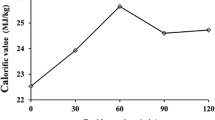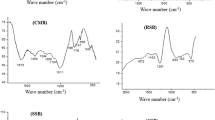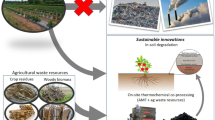Abstract
Pyrolysis of animal manure produces biochar with multiple beneficial use potentials for improving soil quality and the environment. The kinetics and energetics of pyrolysis in producing manure-based biochar were reviewed and analyzed. Kinetic analysis of pyrolysis showed that the higher the temperature, the shorter the reaction time was needed for thermal decomposition and carbonization of animal manure. This kinetic information can assist in producing biochar with a desired proximate composition. Biochar with lower volatile matter (VM) content can be produced with either higher pyrolysis temperature or longer reaction time. Energetically, pyrolysis of wet manures is not sustainable due to high energy needed for drying moisture. However, co-pyrolysis with other high energy density wastes such as agricultural plastic wastes would produce not only energetically sustainable biochar but surplus energy as well. This could be used for local power generation.




Similar content being viewed by others
References
Bridgewater AV (2003) Renewable fuels and chemicals by thermal processing of biomass. Chem Eng J 91(2–3):87–102
Peterson AA, Vogel F, Lachance RP, Froling M, Antal MJ Jr, Tester JW (2008) Thermochemical biofuel production in hydrothermal media: a review of sub- and supercritical water technologies. Energy Environ Sci 1:32–65
Ro KS, Cantrell KB, Hunt PG (2010) High-temperature pyrolysis of blended animal manures for producing renewable energy and value-added biochar. Ind Eng Chem Res 49:10125–10131
Ro KS, Hunt PG, Jackson MA, Compton DL, Yates SR, Cantrell K, Chang SC (2014) Co-pyrolysis of swine manure with agricultural plastic waste: laboratory-scale study. Waste Manag 34:1520–1528
Libra JA, Ro KS, Kammann C, Funke A, Berge ND, Neubauer Y, Titirici MM, Fuhner C, Bens O, Kern J, Emmerich K-H (2011) Hydrothermal carbonization of biomass residuals: a comparative review of the chemistry, processes and applications of wet and dry pyrolysis. Biofuels 2(1):71–106
Boateng AA, Jung HG, Adler PR (2006) Pyrolysis of energy crops including alfalfa stems, reed canarygrass, and eastern gamagrass. Fuel 85:2450–2457
Abel S, Peters A, Trinks S, Schonsky H, Facklam M, Wessolek G (2013) Impact of biochar and hydrochar addition on water retention and water repellency of sandy soil. Geoderma 202–203:183–191
Gaskin JW, Steiner C, Harris K, Das KC, Bibens B (2008) Effect of low-temperature pyrolysis conditions on biochar for agricultural use. Trans ASABE 51(6):2061–2069
Lehmann JA (2007) A handful of carbon. Nature 447(7141):143–144
Novak JM, Spokas KA, Cantrell K, Ro KS, Watts DW, Glaz B, Busscher WJ, Hunt PG (2014) Effects of biochars and hydrochars produced from lignocellulosic and animal manure on fertility of a Mollisol and Entisol. Soil Use Manag 30:175–181
Ro KS, Novak JM, Johnson MG, Szogi AA, Libra JA, Spokas KA, Bae S (2016) Leachate water quality of soils amended with different swine manure-based amendements. Chemosphere 142:92–99. doi:10.1016/j.chemosphere.2015.05.023
Sun K, Gao B, Ro KS, Novak JM, Wang Z, Herbert S, Xing B (2012) Assessment of herbicide sorption by biochars and organic matter associated with soil and sediment. Environ Pollut 163:167–173
Sun K, Ro KS, Guo M, Novak JM, Mashayekhi H, Xing B (2011) Sorption of bisphenol A, 17a-ethinyl estradiol and phenanthrene on thermally and hydrothermally produced biochars. Bioresour Technol 102:5757–5763
Spokas KA, Novak JM, Stewart CE, Cantrell K, Uchimiya M, DiSaire MG, Ro KS (2011) Qualitative analysis of volatile organic compounds on biochar. Chemosphere 85:869–882
Antal MJ Jr, Gronli M (2003) The art, science, and technology of charcoal production. Ind Eng Chem Res 42:1619–1640
Cantrell K, Hunt PG, Uchimiya M, Novak JM, Ro KS (2012) Impact of pyrolysis temperature and manure source on physicochemical characteristics of biochar. Bioresour Technol 107:419–428
Cao X, Ro KS, Chappell M, Li Y, Mao J (2011) Chemical structures of swine-manure chars produced under different carbonization conditions investigated by advanced solid-state 13C nuclear magnetic resonance (NMR) spectroscopy. Energy Fuels 25:388–397
Singh K, Risse M, Worley J, Das KC, Thompson S (2007) Adding value to poulty litter using fractionation, pyrolysis, and pelleting. ASABE Paper 074064
Novak JM, Cantrell KB, Watts DW (2012) Compositional and thermal evaluation of lignocellulosic and poultry litter chars via high and low temperature pyrolysis. Bioenerg Res 6:114–130
Chan KY, Van Zwietern L, Meszaros I, Downie A, Joseph S (2008) Using poultry litter biochars as soil amendments. Austr J Soil Res 46(5):437–444
Sheth AC, Bagchi B (2005) Investigation of nitrogen-bearing species in catalytic steam gasification of poultry litter. J Air & Wastes Management Assoc 55:619–628
Ro KS, Lima IM, Reddy GB, Jackson MA, Gao B (2015) Removing gaseous NH3 using biochar as an adsorbent. Agriculture 5:991–1002
Lima IM, Marshall WE (2005) Granular activated carbons from broiler manure: physical, chemical and adsorptive properties. Bioresour Technol 96:699–706
Lima IM, McAloon A, Boateng AA (2008) Activated carbon from broiler litter: process description and cost of produciton. Biomass Bioenergy 32:568–572
Ro KS, Cantrell KB, Hunt PG, Ducey TF, Vanotti MB, Szogi AA (2009) Thermochemical conversion of livestock wastes: carbonization of swine solids. Bioresour Technol 100:5466–5471
Kirubakaran V, Sivaramakrishnan V, Premalatha M, Subramanian P (2007) Kinetics of auto-gasification of poultry litter. Int J Green Energy 4:519–534
Whitely N, Ozao R, Artiga R, Cao Y, Pan WP (2006) Multi-utilization of chicken litter as biomass source. Part 1. Combustion. Energy Fuels 20:2660–2665
Kim S-S, Agblevor FA (2007) Pyrolysis characteristics and kinetics of chicken litter. Waste Manag 27:135–140
Whitely N, Ozao R, Cao Y, Pan WP (2006) Multi-utilization of chicken litter as a biomass source Part II. Pyrolysis. Energy Fuels 20(6):2666–2671
Raman R, Walawender WP, Fan LT, Howell JA (1981) Devolatilization studies on feedlot manure. Ind Eng Chem Process Des Dev 20:630–636
Wu H, Hanna MA, Jones DD (2012) Thermogravimetric characterization of dairy manure as pyrolysis and combustion feedstocks. Waste Manag Res 30(10):1066–1071
Deenik JL, McClellan T, Uehara G, Antal MJ Jr, Campbell S (2010) Charcoal volatile matter content influences plant growth and soil nitrogen transformations. Soil Sci Soc Am J 74(4):1259–1270
Enders A, Hanley K, Whitman T, Joseph S, Lehmann J (2012) Characterization of biochars to evaluate recalcitrance and agronomic performance. Bioresour Technol 114:644–653
NRCS (2009) part 651 - Agricutlrual Waste Management Field Handbook. USDA. http://directives.sc.egov.usda.gov/viewerFS.aspx?hid=21430. Accessed 9/25 2015
Cantrell KB, Ro KS, Mahajan D, Anjom M, Hunt PG (2007) Role of thermochemical conversion in livestock waste-to-energy treatments: obstacles and opportunities. Ind Eng Chem Res 46:8918–8927
NCSU (1994) Animal and poultry manure production and characterization. http://www.bae.ncsu.edu/topic/animal-waste-mgmt/program/land-ap/barker/a&pmp&c/content.htm. Accessed 9/25 2015
Dupont C, Chiria R, Gauthier G, Toche F (2014) Heat capacity measurements of various biomass types and pyrolysis residues. Fuel 115:644–651
Eisermann W, Johnson P, Conger WL (1980) Estimating thermodynamic properties of coal, char, tar, and ash. Fuel Process Technol 3:39–53
Dahlquist E (2013) Technologies for converting biomass to useful energy: combustion, gasification, pyrolysis, torrefaction and fermentation, Sustainable energy developments. CRC Press, Boca
Mok WS-L, ANtal MJ Jr (1983) Effects of pressure on biomass pyrolysis. II. Heats of reactions of cellulose pyrolysis. Thermochim Acta 68:165–186
Jirka S, Tomlinson T (2014) 2013 State of the biochar industry a survey of commercial activity in the biochar field.
Acknowledgments
The author would like to acknowledge the technical and editorial support provided by Dr. Judy A Libra of Leibniz Institute for Agricultural Engineering (ATB), Potsdam-Bornim, Germany. This research is part of the USDA-ARS National Program 214 Agricultural and Industrial Byproduct Utilization. Mention of trade names or commercial products is solely for the purpose of providing specific information and does not imply recommendation or endorsement by the US Department of Agriculture.
Author information
Authors and Affiliations
Corresponding author
Rights and permissions
About this article
Cite this article
Ro, K.S. Kinetics and Energetics of Producing Animal Manure-Based Biochar. Bioenerg. Res. 9, 447–453 (2016). https://doi.org/10.1007/s12155-016-9724-4
Published:
Issue Date:
DOI: https://doi.org/10.1007/s12155-016-9724-4




